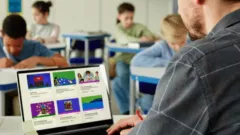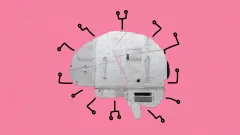Take a look inside 5 images
Mission to Planet Leema: Adventure into Grammar
Pros: Impressive graphics and fun adventure game will reel kids in.
Cons: Learning grammar isn't well integrated into the game.
Bottom Line: Playing could be a fun bonus activity but won't make a big impact on learning.
Students can easily complete the whole adventure in 45-55 minutes, so teachers could have kids play through (using the hints if necessary to finish in time) in a class period. The brief explanations of each grammar concept aren't adequate for new material; however, if kids have already learned about parts of speech, modal auxiliaries, and sentence fragments, they can likely answer the quizzes. Since results are not tracked, teachers may want to have kids track their scores themselves. Students won't be able to pick back up where they left off in the game, either, as it restarts every time it's opened -- so teachers will want to make sure kids have time to complete the mission or have students who have finished it jump in to help students who are struggling, if the class is running short on time.
Pella, a young girl, has landed on Planet Leema (which looks more like a medieval fishing village than a foreign planet) and must find clues and complete missions to locate a hidden gem on the planet. As she finds scrolls and books directing her to the next mission, players complete grammar quizzes. Topics range from identifying parts of speech or recognizing fragments and complete sentences to proper usage of modal auxiliary verbs. Each topic is introduced with a short written definition, and kids can see the correct answer after each question. Once students complete the quiz, regardless of how they scored, they move back into the game.
The idea is a gem: Engaging kids in the problem-solving of an adventure game alongside teaching grammar certainly sounds like a hit. The implementation just doesn't quite work yet. The game itself is gorgeous; it's not too hard for elementary kids just getting familiar with adventure games, and there's some limited help available. The learning part just doesn't quite work. Students or teachers can't choose which grammar concept to focus on, and there's no way to track students' performance. Quite a lot of content is included -- about 500 different grammar questions -- but the game doesn't change or adapt, so kids aren't likely to want to play over and over again to encounter all those questions. Overall, this is a beautifully illustrated world with some potential for learning, and further integrating the grammar content into gameplay would take it to the next level.












